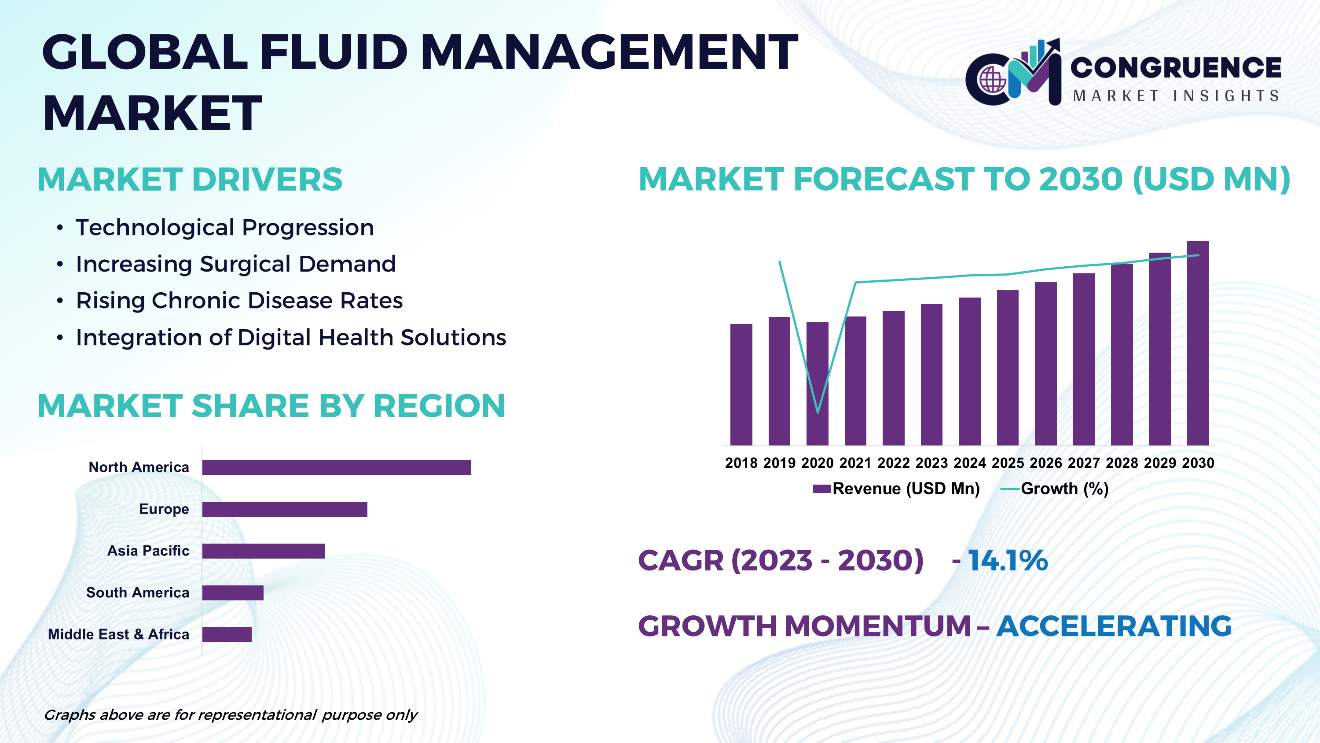Reports
The Global Fluid Management Market is expected to expand at a CAGR of 14.1% between 2023 and 2030. The fluid management market has undergone significant transformation owing to technological advancements and widespread adoption. Initially introduced to address medical requirements in surgeries and critical care, fluid management systems have evolved with technological progress. The incorporation of Industry 4.0 principles, including automation, connectivity, and data analytics, has revolutionized fluid management by facilitating real-time monitoring, precise fluid delivery, and predictive maintenance. This has improved patient safety, workflow efficiency, and cost-effectiveness in healthcare settings. Furthermore, the market landscape has expanded beyond hospitals to encompass ambulatory surgical centers, diagnostic facilities, and research laboratories. Major players continue to invest in research and development to introduce innovative solutions, such as minimally invasive devices and integrated systems, thereby driving further growth and innovation in fluid management technologies.

Fluid Management Market Major Driving Forces
Technological Progression: Continuous innovation in fluid management systems, including minimally invasive devices, integrated platforms, and intelligent sensors, enhances precision, efficiency, and patient safety, fostering market expansion.
Increasing Surgical Demand: The escalating global surgical volume, driven by demographic shifts, advancements in surgical methods, and the rising prevalence of chronic ailments, fuels the need for fluid management solutions in operating rooms and intensive care units.
Rising Chronic Disease Rates: The surging occurrence of chronic conditions like cardiovascular diseases, kidney disorders, and cancer necessitates effective fluid management for diagnosis, treatment, and monitoring, stimulating market growth.
Integration of Digital Health Solutions: The incorporation of digital health technologies such as electronic health records (EHRs), telemedicine, and mobile health apps facilitates seamless data exchange, remote monitoring, and predictive analytics in fluid management, driving market growth.
Fluid Management Market Key Opportunities
Expansion into Emerging Markets: Tapping into developing economies offers substantial growth prospects fueled by increased healthcare spending, infrastructure development, and surgical demand.
Digital Health Integration: Utilizing digital health technologies such as telemedicine and data analytics to enhance fluid management systems' connectivity and insights can enhance patient outcomes and workflow efficiency.
Innovative Product Development: Investing in R&D to introduce inventive fluid management solutions like integrated platforms, smart sensors, and portable devices can differentiate offerings and seize market share.
Fluid Management Market Key Trends
· Innovation in fluid management systems boosts precision and effectiveness in fluid delivery, enhancing patient safety and surgical outcomes.
· The surge in adopting minimally invasive surgical techniques fuels the need for compact, user-friendly fluid management devices.
· A growing focus on patient comfort leads to the development of fluid management systems aimed at reducing complications and expediting recovery.
· Integration of digital health technologies like telemedicine and remote monitoring enhances workflow efficiency and enables real-time data analysis.
· Integrated fluid management platforms streamline workflow and offer comprehensive data analytics, optimizing resource use.
· Heightened concerns about infection control drive demand for disposable fluid management products, driving market expansion.
· Emerging markets witness rising demand for fluid management solutions, supported by expanding healthcare infrastructure and surgical procedures.

Market Competition Landscape
The global Fluid Management market is characterized by high degree of competition among a large number of manufacturers. Key players in the Fluid Management market engage in strategies aimed at gaining a competitive edge. These strategies include product innovation, design differentiation, and the incorporation of sustainable and eco-friendly materials to meet evolving consumer preferences. Established brands leverage their reputation for quality and reliability to maintain market share, while newer entrants focus on disruptive innovations and unique selling propositions.
Key players in the global Fluid Management market implement various organic and inorganic strategies to strengthen and improve their market positioning. Prominent players in the market include:
· Smith & Nephew plc
· Ecolab
· Medline Industries, LP.
· Cardinal Health
· Olympus America
· Zimmer Biomet
· Arthrex, Inc.
· Acteon Medical
· Duomed
· Fresenius Medical Care Asia Pacific Limited
· Baxter
· Stryker
· Medtronic
|
Report Attribute/Metric |
Details |
|
Base Year |
2022 |
|
Forecast Period |
2023 – 2030 |
|
Historical Data |
2018 to 2022 |
|
Forecast Unit |
Value (US$ Mn) |
|
Key Report Deliverable |
Revenue Forecast, Growth Trends, Market Dynamics, Segmental Overview, Regional and Country-wise Analysis, Competition Landscape |
|
Segments Covered |
· By Solution (Fluid Management Systems, Fluid Management Disposables, and Fluid Management Instruments & Tools) · By Application (Arthroscopy, Laparoscopy, Gastroenterology, Urology, and Others) · By End-User (Hospitals and Clinics, Ambulatory Surgical Centers (ASCs), and Others) · By Sales Channel (Independent Small Stores, Specialty Stores, Online Retailing, and Others) |
|
Geographies Covered |
North America: U.S., Canada and Mexico Europe: Germany, France, U.K., Italy, Spain, and Rest of Europe Asia Pacific: China, India, Japan, South Korea, Southeast Asia, and Rest of Asia Pacific South America: Brazil, Argentina, and Rest of Latin America Middle East & Africa: GCC Countries, South Africa, and Rest of Middle East & Africa |
|
Key Players Analyzed |
Smith & Nephew plc, Ecolab, Medline Industries, LP., Cardinal Health, Olympus America, Zimmer Biomet, Arthrex, Inc., Acteon Medical, Duomed, Fresenius Medical Care Asia Pacific Limited, Baxter, Stryker, Medtronic |
|
Customization & Pricing |
Available on Request (10% Customization is Free) |
